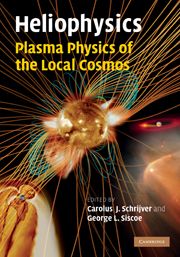Book contents
- Frontmatter
- Contents
- Preface
- 1 Prologue
- 2 Introduction to heliophysics
- 3 Creation and destruction of magnetic field
- 4 Magnetic field topology
- 5 Magnetic reconnection
- 6 Structures of the magnetic field
- 7 Turbulence in space plasmas
- 8 The solar atmosphere
- 9 Stellar winds and magnetic fields
- 10 Fundamentals of planetary magnetospheres
- 11 Solar-wind– magnetosphere coupling: an MHD perspective
- 12 On the ionosphere and chromosphere
- 13 Comparative planetary environments
- Appendix I Authors and editors
- List of illustrations
- List of tables
- References
- Index
5 - Magnetic reconnection
Published online by Cambridge University Press: 05 August 2013
- Frontmatter
- Contents
- Preface
- 1 Prologue
- 2 Introduction to heliophysics
- 3 Creation and destruction of magnetic field
- 4 Magnetic field topology
- 5 Magnetic reconnection
- 6 Structures of the magnetic field
- 7 Turbulence in space plasmas
- 8 The solar atmosphere
- 9 Stellar winds and magnetic fields
- 10 Fundamentals of planetary magnetospheres
- 11 Solar-wind– magnetosphere coupling: an MHD perspective
- 12 On the ionosphere and chromosphere
- 13 Comparative planetary environments
- Appendix I Authors and editors
- List of illustrations
- List of tables
- References
- Index
Summary
Preamble
The widespread interest in reconnection results from the fact that it is a fundamental process that occurs in magnetized plasmas whenever the connectivity of the field lines changes in time. Reconnection is most commonly associated with geomagnetic and solar activity because such changes in field line connectivity can be directly observed, but there are many other, less well-known, applications ranging from meteorites and comet tails to accretion disks and galactic jets. Reconnection is also found in laboratory devices that have been built to study the feasibility of controlled thermonuclear reactors, as well as in several experiments that have been specifically designed to study reconnection as a basic plasma process. Those aspects of magnetic reconnection that depend primarily on the topology of the magnetic field tend to be of universal application. However, aspects that depend on the detailed characteristics of the plasma itself, such as its temperature and density, tend to be restricted to the specific application where such characteristics occur. Thus, there is no universal theory that can be applied to all situations.
Basic concepts
The term magnetic reconnection was introduced by Dungey (1953a), who was interested in the problem of particle acceleration in the Earth's magnetosphere. Earlier studies (Giovanelli, 1946; Hoyle, 1949) had considered the acceleration of particles at magnetic neutral points in the presence of an electric field produced by plasma convection, but these studies did not include the magnetic field produced by the current associated with the motion of the particle.
- Type
- Chapter
- Information
- Heliophysics: Plasma Physics of the Local Cosmos , pp. 113 - 138Publisher: Cambridge University PressPrint publication year: 2009
- 2
- Cited by



